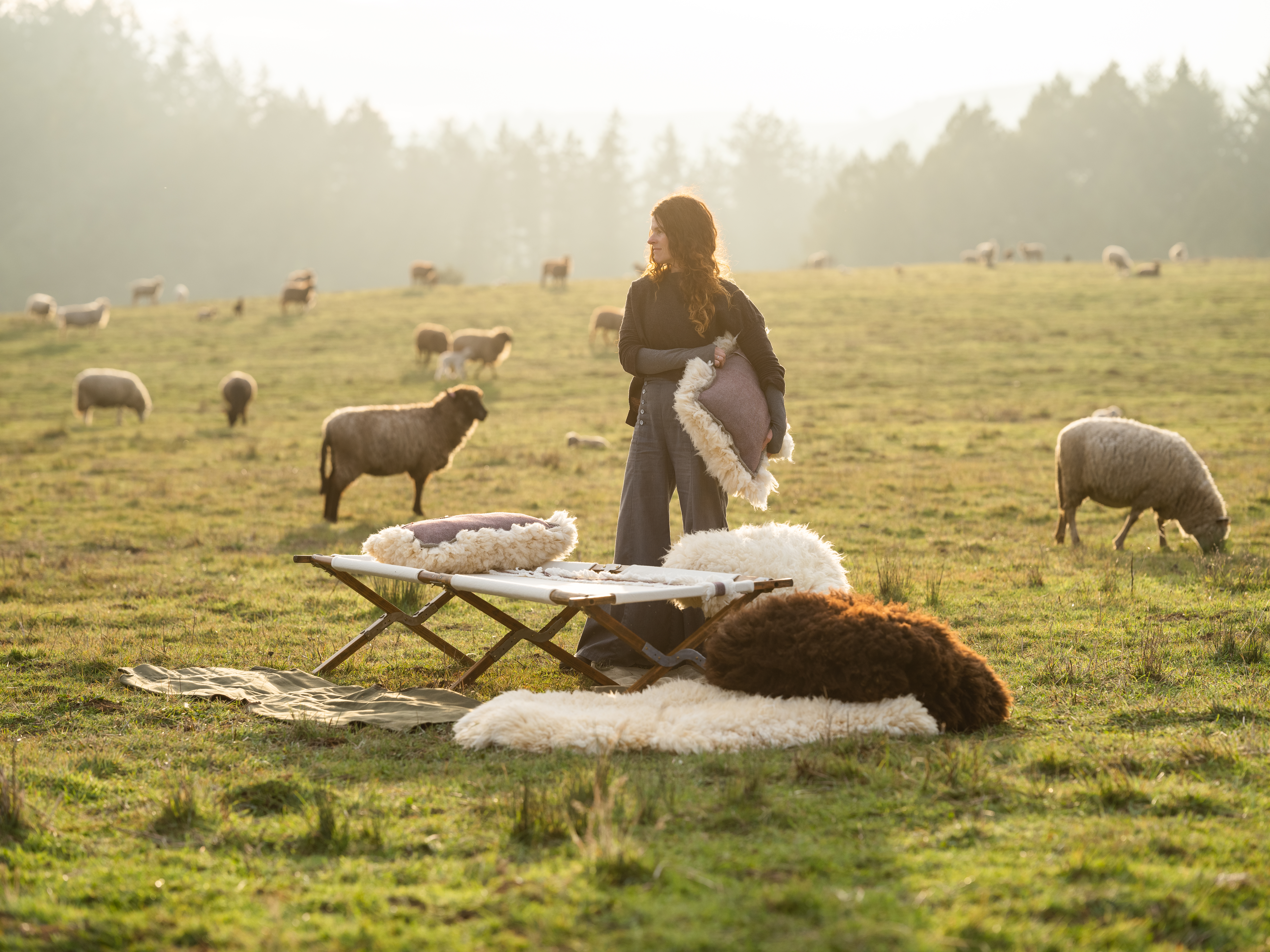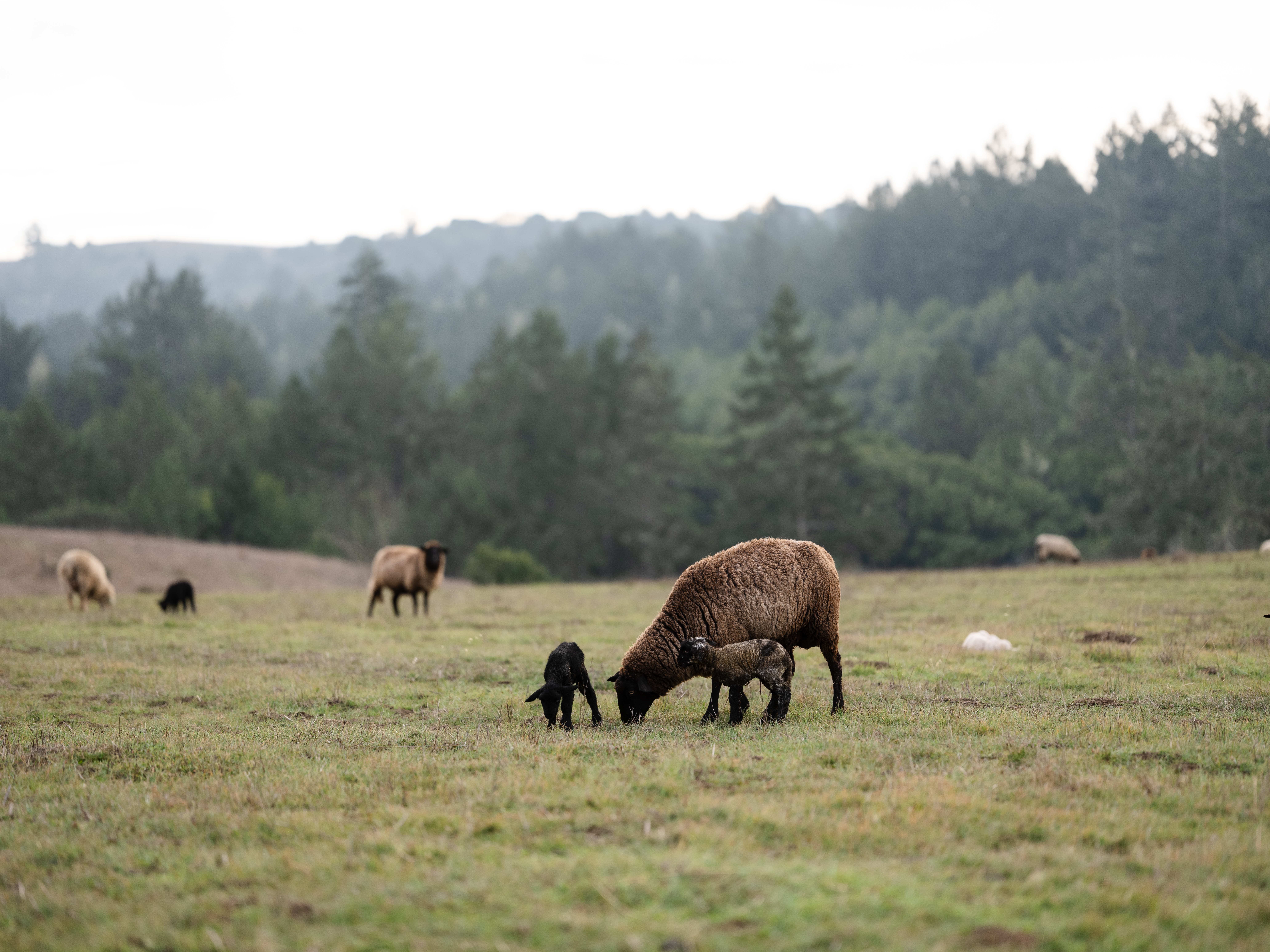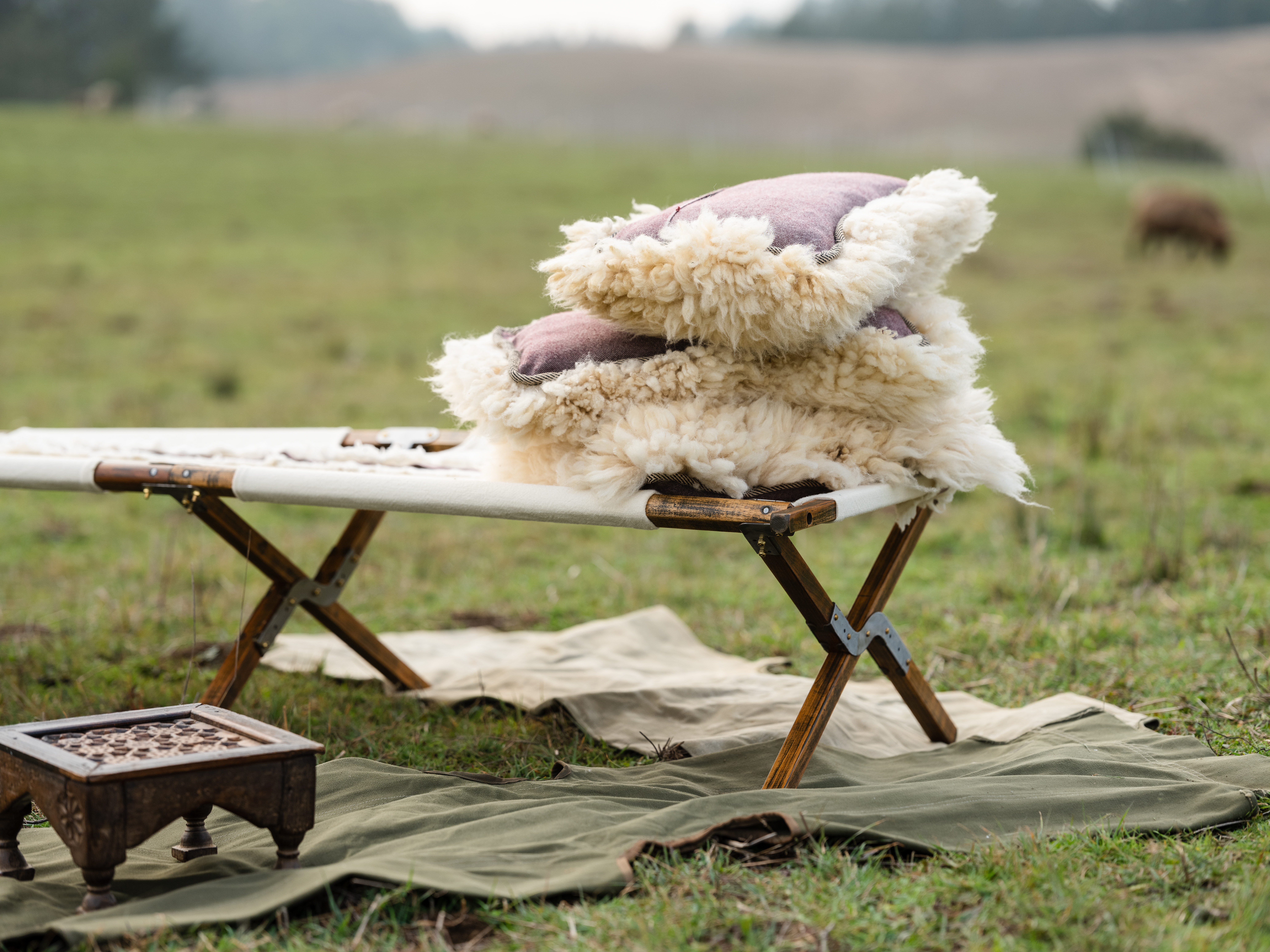Written by Stephany Wilkes. Photographed by Paige Green Photography.

Beth Miles is an established linchpin of the Fibershed community, bringing producers’ goods to viable markets for years. But she is, above all, a master craftsperson and artist. Beth’s industrial design, art, and apparel design and construction skills meet as she works leather, fabrics, and hardscapes; paints, designs and sews. She is the brains and hands behind her Grange Home line, which is a culmination of and departure from her prior life in apparel design. Beth applies the best of what she’s learned and leaves the rest behind.
Quality materials are the foundation of Beth’s craft, and she shows them with joy at the Fog City Flea Trading Post inside the San Francisco Ferry Building Marketplace. January morning sun streams over San Francisco Bay and onto fluffy sheep hides, hand-stitched statement bags, a woven leather chair, and vintage army cots that have been reimagined for their next chapter.
“My designs are less ‘I want it to look like this’ and more ‘What do we already have as a place from which to begin?’” she says. “And what already exists – vintage cots, or sling chairs, table bases – that can be an inspired point of departure? I am constantly thinking of how I can reimagine, combine, or enhance the pieces I find with amazing regenerative materials, and give them their next life. I truly see an opportunity in everything.”
Beth points to a leather chair on an upcycled teak frame. She restored the frame and hand cut twenty undyed, vegetable-tanned leather straps to hold the main leather sling to it. She attached each strap to the sling with brass hardware and secured a hand-sewn Climate Beneficial wool pillow to the top, to support the head.
“I apprenticed at S H Frank & Company to learn all of this, how to work with leather,” she explains. “I taught myself how to work with hides. You learn a little about leather from working with those, but vegetable tanned leather is completely different, and all leather is not the same.”
Vegetable tanning is the established, most environmentally friendly option for tanning leather, and is biodegradable due to the natural substances used in its creation. The process often makes for stronger leathers that, treated with simple natural oils, last at least one lifetime. More common chemical tanning processes, by contrast, are seriously toxic, relying on heavy metals like arsenic (which poisons food and water supplies, and is a carcinogen associated with many types of cancer) and chromium, which bioaccumulates in animals and people, pollutes water and soil, and interferes with plant metabolism, reducing crop growth and yield.
Materials matter, and Beth cannot bear to waste top-quality ones from local farmers and landscapes she knows and loves. She lifts a hand-stitched shearling clutch, a couture statement bag, from a shelf, which she made from sheepskin and fabric remnants.

“I use every scrap and find a place for it, like in these bags. I designed a piece that honored the material, and the cost is based on the time and effort the piece required. It’s a one-of-a-kind, hand-sewn, couture-level statement bag and I will hold onto it until its new owner discovers it. I no longer wish to do the ‘produce, sell, markdown; produce more, sell, markdown; rinse, repeat model. We produce to order and hold a small quantity of inventory so that we are never left with goods that have no home and end up in landfill.”
“I was always a dreamy maker,” she adds. “I am the youngest of eight kids. My father was first-generation American and my mother was a woman of Irish-American descent who made and created endlessly. We didn’t have stuff. There was very little TV. My mother taught us to sew at her knee, using commercial patterns. We knit, we cooked, we did everything with her. And that’s what I wanted to do. Create. Make. My favorite question to my sister was ‘Wanna make stuff?’”
Beth found her first job at a Los Angeles ad agency. She learned about storytelling, she says, particularly the importance of “having a singular message, consistency of voice, and also the challenge of consumers not wanting to take time to understand every single thing about every single product.”
She moved on to design, attending a graduate program at FIT (the Fashion Institute of Technology in New York City) in the 1990s. Beth landed her first design job at Ralph Lauren, on Seventh Avenue at 550 Broadway, organizing large cones of cashmere from Italian mills.
“I had access to a world that doesn’t exist anymore,” she says. “Donna Karan was in the elevator next to Oscar de la Renta. Some manufacturing was still happening in Manhattan. I did lots of listening and learning, took it all in. Ralph Lauren had high expectations.”
Beth recalls the commercial sewing patterns she used at home with her mom and even the pattern standards taught at FIT. “There is, for instance, no collar facing in a Ralph Lauren garment. A facing is not fine enough. Instead there is a tiny binding, and tiny binding is delicate, and expensive. I learned industry versus home standards. Always pin down, never up. We spent our entire days in fittings and I just loved that, learning how to sculpt and make pieces really work. Refinement.”
After a decade in the New York fashion industry, Beth married a New Yorker and they moved to San Francisco, where they had a daughter.

“I realized I’d never see my family if I continued working like that. I also started to ask questions like, ‘Can I get closer to the source?’ and ‘Can I do childrenswear that is not coquettish?’ I had a daughter and I’d look at her and think, ‘She is perfect, beautiful. She needs nothing more than a simple cotton lawn dress.’ I wanted a high quality, built-for-hand-me-downs line for girls that featured swiss dots, dark denim, baby-wale corduroy, and the luscious fabrics I recalled from my own childhood in Chicago. And the fact is, people spend more money on girls’ clothes than on boys’, and I knew that a domestic product would cost more. I found a factory in South San Francisco, bootstrapped it, scaled it. I called it Ses Petites Mains Tiny Chic Clothing, which means ‘their little hands,’ a double entendre for little kids and the hands that create couture stitches.”
By 2015, after ten years of success (and through two global financial collapses), Beth had run her course with Ses Petites Mains.
“Everything felt like a race to the bottom. There is too much cheap product. There is just too much stuff. Everyone was challenged to be Amazon, with free shipping, same-day shipping. I was not going to join the race to the bottom but I wasn’t sure what I was going to do.”
Then, Beth says, I met Sallie Calhoun, who hooked me with her inspiring soil talk. (Sallie is the founder and owner of the regenerative Paicines Ranch and the #NoRegrets initiative.) Sallie excitedly introduced me to Rebecca Burgess, the founder and Executive Director of Fibershed, and it was this sudden moment of, ‘Oh! This stuff is happening?!’ Finding Fibershed was a coup d’etat. I heard my own values in Rebecca’s story and more: I had no idea that fibers could enrich our planet in the way that they do, helping to draw down atmospheric carbon and creating soil health. And with the level of quality of the Fibershed producers’ materials, I felt like I was back at Ralph Lauren but better. I began to think, ‘If I was going to do products again, this is what I would want to do them in.’”
Beth began to see a path forward. She started to work directly with Fibershed producers, creating trunk shows and pop-ups, and the Grange Home line grew from there. Today, Beth designs and crafts products that are investment pieces.
“I lead with beautiful design and I will only work local. I start there. It is sustainability at its finest,” she says.

Beth is especially proud of her wood-framed Army cots, in use before World War II and through the Korean War, before aluminum frames were introduced.
“They’re so simple, so practical. They had to be sturdy and transportable – yet they are so sophisticated, chic, modern and smart, like a Mies van der Rohe Barcelona chair. The cots remind me of my dad. He was a World War II Marine stationed in Hawaii. We would go to the Army Navy surplus store when we were young – even though my dad was a pacifist, anti-gun, very principled – because they had things that were high quality and affordable, and the store supported our community. My father was hugely civic minded and I try to honor that, in his memory.”
Beth completely deconstructs each wood frame, then sands and cleans all of the metal fixtures and wood supports. Next, she reconstructs the frame with new brass hardware, and cuts and sews a new cover made of either Climate Beneficial wool, vegetable-tanned leather, or deadstock denim or wool, at times with a sheepskin appliqued on top. The craft lessons she has learned along the way are in evidence on Grange Home offerings: a tiny binding on the edge of a new wool cot cover, topped with a Gotland sheepskin; tight, even lines of hand stitching between woven fabric and bias edge.
“The first time I got a cot, I fixed it up and thought, ‘What if I create a patchwork denim textile from old Levi’s 501’s in place of the canvas?’ A friend saw it and immediately bought it. And I just kept going.”
Beth even took on furniture delivery during 2022, when fuel and shipping costs spiked.

“It was wild but it gave me a chance to see the spaces where my cots would live,” she says. “I love to meet my customers, see how they are using something I made. I am so honored that people with beautiful spaces see my pieces in them.”
Grange Home cots have found their way to Santa Monica offices that overlook the Pacific, to various homes as nap and weekend cots for visitors, and to provide comfort after endless Zoom calls. Vineyard customers move them outdoors for afternoon gatherings, “a way to add elegance outdoors, especially with Covid,” Beth says. One cot lives on the mezzanine of a young tech worker’s loft, and a woven leather cot recently sold to a Vietnam veteran in Hawaii.
“He wants to use it as indoor-outdoor piece,” she laughs, “and I keep saying ‘Just don’t leave it out overnight!’”
Beth is profoundly grateful for her relationship with Fog City Flea Trading Post, which gave Grange Home a start and, for the past year, her own retail space too. In January of this year, Beth opened a Grange Home outpost within Fog City’s newest endeavor, Market Market in Palm Springs.

“James Morelos – who started Fog City and Mojave Flea, The Southern Flea, Market Market, and more – is transforming retail,” Beth says. “Fog City initially held weekend-long pop-ups, which I joined in November 2021. I had cots, small bits of what I have now. I used the experience as a test market and it received a great reception. People saw my work like I hoped they would, and it just started to go. William Brennan, Fog City’s General Manager (now Creative Director), was also a fantastic partner who helped me strategize about how I could move into their permanent space, which opened in February 2022.”
Like her children’s line, Grange Home is bootstrapped.
“It is all personally funded. It’s a cash-flow thing,” she explains. “It’s a different kind of product. Something like this is going to have a longer response time. A $1,700 cot needs time to percolate, and that is okay. I wanted a systems shift from mass industrial to craft and enduring, beautiful, timeless design. I can’t change everything, but this is what I can change. This is my statement about sustainability. It’s luxury reimagined: If we have the privilege to choose, why wouldn’t we choose this? Why wouldn’t we choose health, wellbeing, community?”
